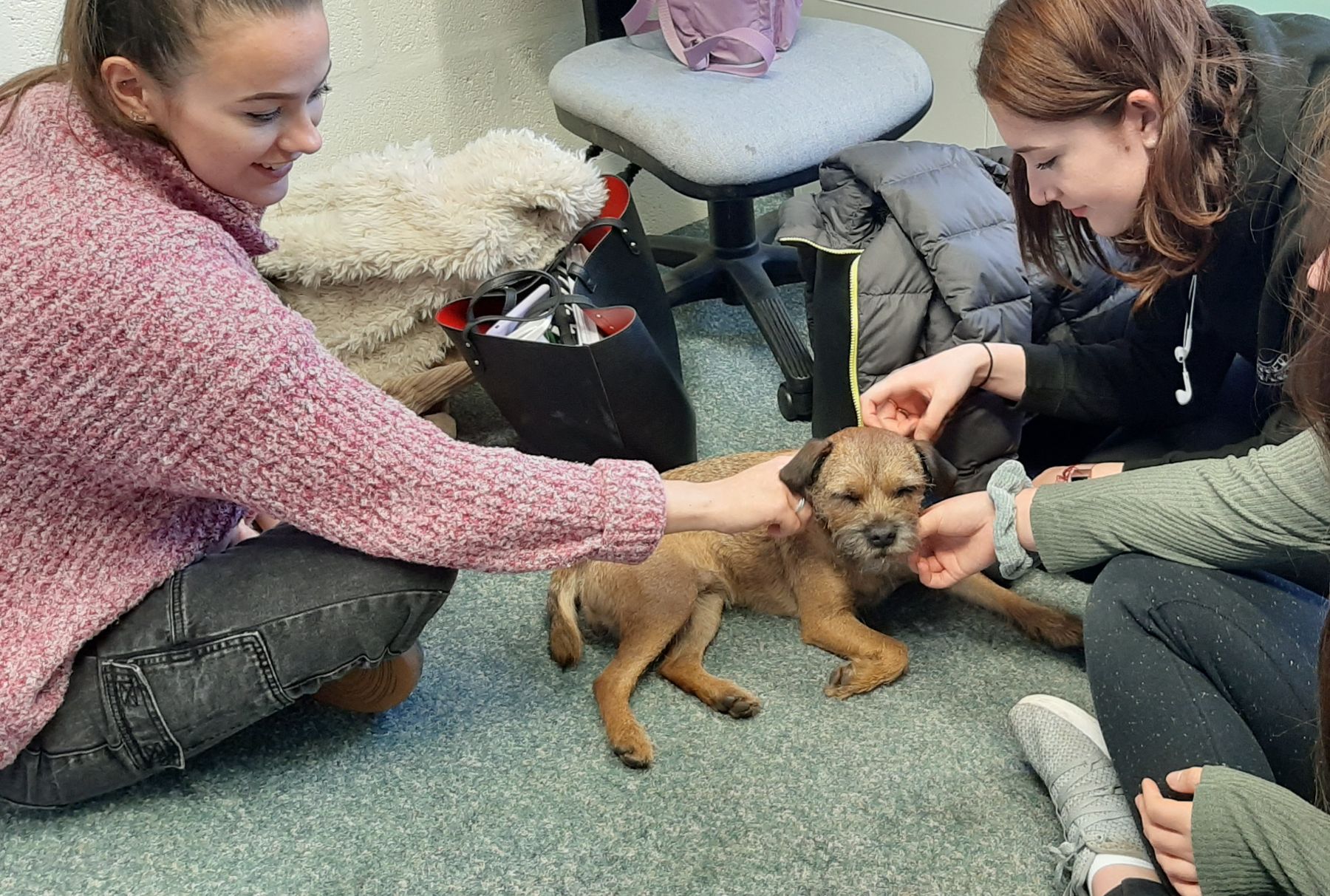Dogs for Welfare
Bringing pet dogs into the workplace to enhance wellbeing.
Your wellbeing
Student and staff wellbeing are paramount when it comes to receiving a well-rounded and effective education. We look at how we can enhance wellbeing and help manage the stresses of everyday life.
In 2018 our own first year students listed their pets as the thing they miss most. We know that interacting with animals can have lots of benefits.
We decided to explore this within the School of Psychology. We set up the Dogs for Welfare scheme which lets our staff's dogs visit the department on designated days.
Staff and students can interact with these dogs and join them on their daily walks.
Our scheme
We began the conversation in October 2018 which started a nine month consultation period.
We looked at similar schemes that exist, especially the Purina’s Pets At Work Scheme. They offer support to others via the Pets At Work Alliance.
We drafted an initial framework of rules and guiding principles and discussed them at a departmental meeting. You can view our framework and presentation in the resources section below. An anonymous ballot found the majority of people were in favour of the initiative.
We set up a steering group to discuss how to take the proposal forwards. This included both people who were for and against the scheme.

Issues to resolve
Through this we identified specific issues to resolve:
- allergies
- phobia or dislike of dogs
- dog welfare
- cleanliness
- injuries
- liability
We reached out to lots of knowledgeable people in our University, and consulted relevant stakeholders:
- people services
- health and safety
- estates
- wellbeing
- insurance
We then conducted a full risk assessment. This is available in our resources section below. We took baseline measures of workplace quality of life, work friendship and trust between colleagues. These are all factors that the presence of dogs are suggested to influence.
Our first dog, Sammie underwent a temperament assessment and began visiting the department one day a week.
Outcomes
The scheme has been popular with students in particular. Sammie has an average of 22 visitors per week.
Visitors often comment that seeing the dog helps them feel more relaxed or happier. It has increased social interaction between staff in the department too.
In October 2019, Sammie featured on BBC1’s ‘Look North’ news programme. It reported on some of the wellbeing initiatives at the University that involve dogs.
So far there have been no untoward incidents or complaints. There has been no extra mess or noise as a result of the dogs coming in.
We found that sometimes lanyards swung into dog's face when colleagues bent down to pet them.
We also found that the dogs need time to acclimatise to strange things, including:
- strange textures, like lino covered stairs
- lifts
- automatic doors
- the sound of people walking past offices
Sammie
Sammie is a four-year old female border terrier. She was the first dog to start coming into the department in June 2019.
She enjoys tummy tickles and chest rubs, chasing balls and sleeping in the sun.
Her hobbies include dog agility and drama - she has starred in a number of plays. Sammie visits the department on Tuesdays.
Anyone can visit her or join her on her lunchtime walk along with her owner Lucy.

Allergies
Pet allergies are relatively common, affecting 13-19% of the population. They are triggered by direct contact such as stroking the animal or touching where the animal has been lying.
Pet allergens are not airborne, so ensuring the dog’s resting place is 5 metres from an allergy sufferer is an effective strategy.
Communal areas such as kitchens, toilets and some meeting rooms should be kept dog-free. Clear signage should be used to show a dog is in the department and where those with allergies should avoid.
Phobia or dislike of dogs
Not everybody wants to interact with dogs, this can be for a variety of reasons.
To make sure no one was uncomfortable we identified dog-free entry and exit routes in our building.
For example, dogs must use the stairs and not the lift. The dog is signed in and out so anyone wishing to avoid it can know where it is at any point in time. The dog is only permitted in certain parts of the department.
Dog Welfare
It’s important that the dog also receives a positive experience. We give all our dogs a temperament assessment before coming into the department.
This helps us check that the dog is likely to be suitable to coming in to work. We stay mindful of how the dog is managing, watching for signs of discomfort, avoidance or anything else suggesting that they are unhappy in the work environment.
We can assess if changes are needed or whether the dog should continue coming to work.
Dog owners must make sure their work commitments that day won’t leave the dog alone for long periods. Visitors are also limited so the dog can get sufficient peace and quiet.
Cleanliness
Dogs adhere to a different set of hygiene standards to humans and even the cleanest dog sheds a bit of hair or gets that ‘damp dog’ smell when it rains.
We found no need to change our department’s regular cleaning schedule. We have towels to dry damp dogs, and a cleaning kit and enzyme spray for use as needed.
Risk
It’s important to think about the risk of a dog biting someone and what actions can be taken to reduce this risk as much as possible. Dog bites are relatively rare (annual incidence 1.8%) and two thirds do not require any medical intervention.
We asked Dr Lucy Asher, an expert in canine behaviour, to provide a work-based assessment of the dog. The owner completes a questionnaire exploring the dog’s reactions to a number of different scenarios. We assess the dog’s reaction to a number of potential triggers, such as:
- being touched by a stranger
- being touched roughly
- having food and a toy taken from it
- approaching its bed or its owner for signs of possessive aggression
- reaction to a loud noise
An office environment has features which most dogs do not normally encounter. We also assess the dog’s comfort in the environment, including:
- new textures, such as lino-covered stairs
- lifts
- automatic doors
- office chairs wheeling towards them
- identity lanyards swinging towards their face
At all times the dog’s owner is legally liable for the dog and any damage or injury the dog causes. Even if that dog is being looked after by someone else at the time. We recommend that they have appropriate insurance to cover this.
Liability
As the dog is not the property of Newcastle University it is not covered by University public liability insurance.
The dog’s owner is at all times responsible for their dog and is liable to defend any claim resulting from their dog causing damage and/or harm to property, another person or another dog. This applies even if a colleague or student, who is not the dog’s owner, is temporarily looking after the dog or walking them.
We currently ask owners who bring their dogs to work for evidence that they have an insurance policy that provides adequate cover for damage to third party property or injury to third parties (including fellow employees and their dogs) and that their insurance company is aware that the dog attends the workplace.
Owners must agree to cover any cost(s) associated with damage to third party property or injury to third parties (including fellow employees and their dogs).
Resources
- Dogs for Welfare Guiding Principles (PDF:438KB)
- Pet Dogs at Work Presentation (PDF:3MB)
- Pet Dogs at Work Risk Assessment (PDF:288KB)

